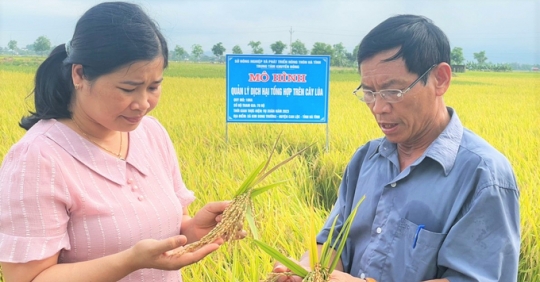
Households participating in the integrated pest management model are “hand-held” from the sowing phase by technical staff who take care of the spraying of pesticides. Picture: N Hoan.
The Integrated Plant Pest Management Program (IPM) has been applied to rice production in Ha Tinh for many years. Finally, this solution is not new, but the effects it brings are always new and oriented towards a sustainable agricultural technique, such as: reduction in production costs, reduction in the amount of toxic pesticides. Residues on products that ensure human health create safe products, protect field ecosystems and increase profits on the farmland.
In the spring harvest of 2023, Ha Tinh Agricultural Extension Center successfully applied IPM to an area of 10 ha, involving 70 households in Dinh Ho Village, Kim Song Truong Township (Can Loc District).
Under the model, households were trained on IPM issues by the Ha Tinh Agricultural Extension Center, which helped reduce the amount of fertilizer used by 10-15% compared to traditional farming; protection of natural enemies in the field; Reduce the number of sprayings and use of pesticides by 1-2 times per crop compared to conventional farming. The cost of applying IPM paddy field is 15-17%/ha lower than conventional paddy field mainly by the cost of fertilizer, pesticide and labor.

Through the IPM program, farmers record the harmful organisms on rice, natural enemies in the field, investigate and offer scientific and safe treatment measures for the environment. Picture: N Hoan.
Mr. Dao Khac Que, a household participating in the model, said he was guided by staff during the production process from sowing to fertilizing to spraying pesticides. Regular field visits enable farmers to use the criteria to assess, monitor and identify pests and diseases in good time, thus limiting the use of pesticides and making better use of medicines.
“Through the IPM program, we have grasped the harmful organisms on rice, the natural enemies in the field, the investigation method, and proposed scientific and safe treatment measures for rice. environment,” said Mr. Que.
Ms. Hoang Thi Lai, another household participating in the sharing model, was initially worried, herself and other households in the village because they often sow thick seeds, not following a process that the owner has made weak from his own experience .
After participating in the IPM model, reality has shown many benefits, such as: B. Reducing the amount of seed from 3.5-4kg/sao to 3kg/sao, rice is sown and then transplanted evenly and developed with a transplanter. Good quality, fewer weeds, healthy rice plants, good resistance to pests and diseases, and good fall resistance. At the time of the great rice harvest, the proportion of cereals is high, the grain is granular, the yield is estimated at 3.4 quintals/sao (500 m²), 0.4 quintals/sao more than traditional production, and businesses are dying to buy rice. Fresh in the field.

The use of IPM in rice production has helped reduce production costs. Picture: N Hoan.
“The introduction of the Huong glutinous rice variety into production in the model shows that it is suitable for local conditions. In addition, glutinous rice is easy to eat and has a good price, so we make quite a profit after deducting the cost,” Ms. Lai said.
Although the participating area is not large, the application of the IPM model to rice is a solid premise for VietGAP, organic farming, production in accordance with provincial regulations and standards, and contributes to the sustainable promotion of agricultural development.
According to Mr. Nguyen Tri Ha, Chief of Plantation and Crop Protection Sub-Department in Ha Tinh, Ha Tinh applied the IPM program for the first time in 1993 under the auspices of the Food and Agriculture Organization of the United Nations (FAO). Used in rice production. The model was successful and opened a new direction in applying technical advances to agricultural production.
In the years that followed, Ha Tinh opened regular training courses, transmitted the process and is now being used quite successfully by farmers.

